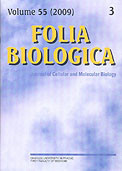Smetana K, Zápotocký M. Folia Biol (Praha). 2010 56(5):201–5. IF: 0.924

Abstract:
The present study was undertaken to provide more information on nucleolar changes induced by a histone deacetylase inhibitor such as valproic acid in leukaemic myeloblasts at the single-cell level. For this study, RNA in nucleoli was visualized by a simple but sensitive cytochemical procedure in unfixed cytospins of short-term bone marrow cultures from patients suffering from acute myeloid leukaemia. Valproic acid in leukaemic myeloblasts markedly reduced the nucleolar size and also produced significant transformation of „active“ to „resting“ and „inactive“ nucleoli that reflected the alteration of the nucleolar transcription in sensitive myeloblasts. On this occasion it should be added that valproic acid significantly increased the incidence of altered myeloblasts that changed to apoptotic cells or apoptotic bodies and cell ghosts. In contrast to the above-mentioned decreased nucleolar size, the nucleolar RNA concentration, expressed by computerassisted RNA image densitometry in valproic acid treated myeloblasts, was not significantly changed. The results of the present study clearly indicated that the nucleolar size and transformation of „active“ to „sleeping“ or „inactive“ nucleoli are convenient markers of the sensitivity and alteration of leukaemic myeloblasts produced by a histone deacetylase inhibitor, valproic acid, at the single-cell level.
-az-
